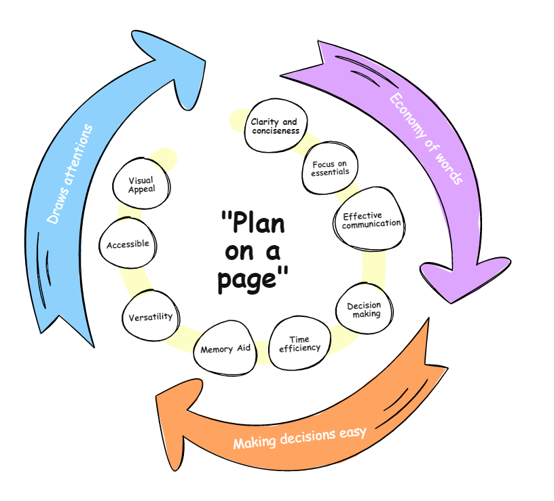
How many times have you been in a meeting, with multiple documents which have been expected to be read. You’ve ran out of time prior to the meeting and you are furiously skimming the documents shared at the start to make sure you have an idea of the key issues. You miss out 80% of the content and whilst you are distracted you miss the first 15 minutes of the meeting… . You think to yourself, “I hope nobody asks me a question now as I don’t have a clue what’s going on”.
This is not to say that extended documentation isn’t important and we do advocate, deep and detailed thinking related to complex issues. This long form analysis is key to being able to summarise effectively. However, once the long form doc is written, we can be guilty of stopping there, as the ‘work is done’…Wrong. We are doing ourselves and colleagues a disservice when we slap a 30-page document down and expect them to absorb all this information quickly. This puts a huge strain on our colleagues and also reduces the impact of the message you are trying to deliver by hiding it amongst another 5000 words. Research shows that just listening or reading information is one of the most passive and unproductive ways to retain information. This is compared to audio-visual learning, where using charts, infographics and pictures can increase knowledge recall by 10% more than the former two techniques.
Although producing summaries which are visually appealing may take longer, the wider benefits are often not quantified and does beg the question why we don’t prioritise the extra time to summarise our reports and findings. Making them more digestible, helping to make decisions more effectively.
In Quality Improvement, we use multiple approaches for this, but an effective approach which can be used universally is the A3. This is fundamentally a way of thinking, however practically it is (usually)involves several steps which utilises:
An initial phase to understand the problem, the current performance/state and goal setting
Followed by root cause analysis of the issues faced and interventions development.
Concludes with a series of action completion, review of results and agreement on ongoing monitoring (example below)

Summarising lengthy reports into one pagers employs a number of tactics to support knowledge recall and information consumption. We have outlined several reasons why using tools like A3 can support any piece of work you are doing:
Economy of words
-
Clarity and Conciseness: Summarising your ideas forces you to distill your thoughts down to their core elements. This clarity and conciseness make it easier for others to understand your message quickly, especially in situations where people may have limited time or attention.
-
Effective Communication: In many professional settings, concise communication is highly valued. A well-structured one-pager can effectively summarise your key points, making it easier for your audience to grasp the main ideas without getting bogged down in details.
-
Focus on Essentials: Creating a one-pager forces you to prioritise and focus on the most critical aspects of your idea. This can help you identify and emphasise the key strengths or selling points of your proposal.
Making decisions easy
-
Decision-Making: Decision-makers often consider a wide range of information sources when making choices. A one-pager can serve as a quick reference point, helping these decision-makers assess the key aspects of your proposal, project, or idea swiftly.
-
Time Efficiency: People are generally busy and a one-page summary respects their time. By providing a brief overview, you demonstrate respect for your audience’s schedules and responsibilities.
-
Memory Aid: One-pagers can serve as memory aids, helping your audience recall and retain the main points of your presentation or proposal. This can be particularly useful when discussing complex topics or during group meetings where many ideas are presented.
Draws attention
-
Accessibility: In some situations, such as grant applications or project pitches, there may be strict page limits. A one-pager ensures you can provide necessary information within those constraints.
-
Versatility: One-pagers can be easily shared via email, printed for meetings, or included in reports. They are a versatile tool for conveying information in various settings.
-
Visual Appeal: A well-designed one-pager can be visually appealing, drawing attention to your ideas and making them more memorable.

Despite the many benefits of using the A3, plan on a page, summary report or any other manner of names which can be used, there can often be barriers to use from my experience. Apart from the time element which can often be banded around, A3’s can very transparent. Lengthy documents can help to hide any issues with progress, therefore summarising performance or project work can be quite revealing and uncomfortable. It also takes practice to do, like anything. Summarising thoughts down into their constituent elements is hard and trying to cram all the original information on to one page can often lead to people just using smaller text. Sitting down and really thinking about what the audience needs to hear or see is key but not always natural. It’s important to remember that you will always have the safety of the longer report to elucidate any details that you think is important.
In brief, summarising your ideas onto one page of paper is valuable because it promotes clarity, efficiency, and effective communication and I would challenge back to say that in the long term will save you time by reducing bureaucracy and having to explain your approach. It helps you focus on the essentials and ensures that your message is accessible and memorable to your audience. So next time you have a lengthy paper to write, I urge you to add an extra half hour to your planning and try to summarise your major thoughts and requirements onto one page and see what the impact is. I guarantee you that you will see the returns on your time investment. Let us know how it goes!
Cheers
Tom
References
Learning Retention: Must-Try Strategies to Boost It Right Away (ispringsolutions.com)
https://www.lean.org/lexicon-terms/a3-report/
Understanding the Science Behind Learning Retention | Reports | What We Think | Indegene
